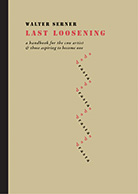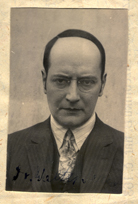by ELLIE RAMBO

Walter Serner, Last Loosening: a handbook for the con artist & those aspiring to become one (Twisted Spoon Press, 2020), pp. 189.
The “Last Number” from Walter Serner’s Last Loosening, recently translated from German by Mark Kanak, serves as the most concise summary of the book itself:
-
-
- To be sure, the world wants to be deceived. And it becomes truly malevolent if you don’t oblige.
-
The handbook, published and republished in fragments throughout the 1920s, began as a Dada manifesto from one of the founders of that avant-garde movement. After Serner’s colleague Tristan Tzara plagiarized ideas from an earlier version of the work (which becomes “Part 1: The Handbook of Principles” in this translation), Serner drifted from Dadaism. In the edition Kanak translates, Serner replaces the word “dada” with “rasta,” derived from “rastaquouère,” a word used to describe a nouveau riche foreigner. As Kanak explains in a footnote, the rastaquouère’s association with dubious claims of wealth puts the concept in parallel with con artistry, and it is this meaning upon which Serner draws. Early in the book, Serner describes a rasta as “the desperado (oh what a sweetie!) who gets up to all sorts of shenanigans as a prophet, anarchist, statesman, etc.” Serner himself changed his name and religion—he was born as Walter Eduard Seligmann to a Jewish family and converted to Catholicism in adulthood—but his closest tie to con artistry is not as someone with a recreated identity, but as “the desperado… who gets up to all sorts of shenanigans.” Like other Dadaists, he expressed his anti-militaristic, anti-establishment views using various pranks and jokes. Kanak’s afterword recounts one of these: Serner sent an anonymous tip alleging that he himself was a Bolshevik spy; as a result his mail service was blocked.
Kanak’s afterword and footnotes are a highlight of this edition. Without them, the first third of the book is nearly incomprehensible to the average reader. Serner’s principles in this section are almost gruelingly allusive, and they are interrupted by parenthetical interjections. What can be understood: the outlook here is nihilistic—“Around a fireball speeds a glob of excrement upon which ladies silk stockings are sold and Gaugins discussed”—without subscribing to a specific philosophy—“One need not have read either Kant or Nietzsche: a single line is enough to induce vomiting.” Political progress is suspect—“there has never yet been a revolution”—but imperial wars are even more fraudulent:
-
-
- War! C’est la guerre! Walk right in, gentlemen! Simply walk right in! . . . These dear folk don’t even know why they even exist, nor what was and what will be, and even the most subaltern deliberation that they are serving the private machinations of supreme individual swindlers will change little in their thinking; nor will the knowledge that those directing their battlefield deaths are staging this drama solely because they, too, are bored. The majority then begin to shoot not because they don’t see through this hoo-ha, but because they take it as a (hoho!) sensation….
-
In Serner’s post-WWI perspective, war has no purpose beyond giving “the gentlemen up in his loge… his spectacle” and offering “the populace a bloody way to pass the time.” He offers a cynical version of pacifism, rather than a revolutionary one, since the alternative to war is “hideous boredom.” His view of most things is cynical, as he establishes in the book’s first part, “The Handbook of Principles,” and reemphasizes in its second, “The Handbook of Practices.” Since “morality is the least expedient means for handling any sort of business,” Serner advises his reader to give up this “concocted idea of the worst kind” and instead embrace the life of the con. The second part of the handbook is devoted to advice for the aspiring con artist.
“The Handbook of Practices” often reads like a twisted version of a self-help book, although there are no life-affirming quips or empowering anecdotes. Instead of advice about how readers can become the best, truest versions of themselves, Serner advises his readers to become selves who can manipulate others and protect their own interests. But if mainstream self-help books rely on certain types of performance and illusion—the performance of one’s own personality and the illusion of optimization, for example—this guide is those books’ distant cousin. At its funniest points, it reads like a mockery of rise-and-grind culture or the Instagram-graphic self-help genre:
-
-
- Never meditate. Only devise schemes, prepare to dupe, and do not procrastinate.
- Stand in front of a large mirror, often. Cast loving glances at yourself. Act up in front of yourself. Try to become more enthusiastic about yourself. Praise yourself. Be amazed at yourself. But scold yourself, too.
- Practice your gaze daily while standing in front of a mirror. Your eyes must be trained to keep still and fixed on the other person, to quickly veil you, to sting, and to complain. Or, to exude so much experience and knowledge that your counterpart extends his hand to you in fear.
-
It’s hard to imagine that Serner is taking this advice seriously himself, especially within the wider context of the handbook. One of the best conceits here is the “Preparation” chapter for each section, in which Serner instructs us to order a complicated menu of items, which he then cues the reader to eat in later pages at specific moments. I have to admit I did not order “Eggs Florentine (cherry),” “Langouste sauce mayo,” or “Chartreuse jaune” while reading, but I do wish more books came with read-along menus. Although not part of the menu, there is at least one piece of food-related advice from the book worth following:
-
-
- In those hours of profound self-loathing, never completely avoidable as the indomitable longing for an inner foothold creeps over you when, above all, you’re keenly aware of the fiasco of your own existence and agonizingly aware of the great nothingness we all face, do the following: drink two cups of hot chocolate, take an aspirin, and lie down in bed.
-
Less palatable is the chapter of advice about women, which on the whole has not aged well. Many of these tips are somewhat boring (“If your lover suddenly becomes very affectionate with you, then she’s surely betrayed you just a few minutes earlier”), while others are cruel (“If a woman asks you what’s the safest way to prevent pregnancy, then don’t waste another second on her. She’s either homely or ill”). Unfortunately, there is too much of this for most casual readers with only a passing interest in Dadaism, and readers who pick up the book expecting glamour and intrigue to accompany the con artistry will likely be disappointed, too. Rather than describing outlandish schemes—or even basic tricks—this handbook offers advice about how to conduct oneself in a hostile world. It assumes the only way to avoid being conned is to have enough faith in your own charade to become a con artist yourself. This aspect is another strange echo of some self-help books: the “con” in “con artist,” after all, is short for “confidence.”


